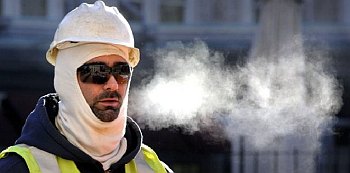 Indiana’s varying seasonal weather can make it difficult for Hoosier employers to stay sharp about protecting their employees from weather-related hazards. As winter rolls back around, it brings with it obvious risks, such as icy driving conditions, as well as not-so-obvious but potentially deadly risks.
Indiana’s varying seasonal weather can make it difficult for Hoosier employers to stay sharp about protecting their employees from weather-related hazards. As winter rolls back around, it brings with it obvious risks, such as icy driving conditions, as well as not-so-obvious but potentially deadly risks.
With proper preparation, these risks can be minimized or avoided.
Indiana workers who work outside or in poorly insulated structures are at increased risk of suffering cold stress injuries, while those who work in certain types of indoor facilities could be threatened by carbon monoxide (CO) overexposure.
The three most common cold illnesses are frostbite, hypothermia and trench foot. Injuries related to cold temperatures can be avoided by ensuring employees are properly trained, stay dry, account for wind chill and wear appropriate personal protective equipment and clothing.
Increased exposure to CO is another cold weather hazard. This risk may become more prevalent as facilities close overhead doors to maintain indoor temperatures. CO is an odorless, colorless and tasteless gas that displaces oxygen and is created whenever something burns. Improperly or poorly vented furnaces, space heaters and running engines are common contributing factors to CO in workplaces.
Symptoms of overexposure to CO may cause confusion, nausea, headache, fatigue, unconsciousness and death.
Illnesses related to CO overexposure can be avoided by:
1. Installing an effective ventilation system that removes CO from the work area;
2. Ensuring equipment and appliances are in good working order;
3. Training employees to recognize and report hazards, unsafe conditions or symptoms of CO
overexposure.
Workers should not be permitted to use gasoline-powered engines or tools in enclosed, poorly ventilated areas.
For more information, view OSHA’s CO factsheet.
Resources for preventing cold stress include:













